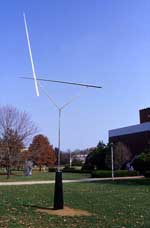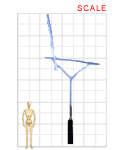VAM galleries including this work:
University of Kentucky Art Museum | How’d They Do That? || VAM Home
George Rickey (American, 1907-2002)
TWO LINES OBLIQUE, 1967-69
Stainless steel; 27' X 34' X 21-1/8"
Bequest of George and Susan Proskauer, 1992.17.78
University of Kentucky Art Museum—Art © Estate of George Rickey/Licensed by VAGA, New York, NY
George Rickey, one of America’s foremost sculptors, is known for elegant stainless steel works that gracefully and silently react to the whims of passing air currents. Rickey’s sculptures are manifestations of continual motion that epitomize the laws of nature. The twirling and spinning facets of his smaller works and the sweeping arcs and scissor-like blades of his monumental outdoor installations—including Two Lines Oblique—are a unique blend of an artist’s formal language and an engineer’s superb craftsmanship. His kinetic sculpture makes the invisible visible, turning gravity and physics into poetry.
About the Artist
George Rickey was born in South Bend, Indiana, the grandson of a clock maker and the son of an engineer. He spent most of his childhood in Scotland, where his father was transferred when George was 5. He studied humanities at the University of Oxford’s Balliol College and painting in Paris. In the 1930s, he took a teaching position at Boston’s Groton College. During World War II, Rickey served in the Army Air Corps. His work testing the computing instruments used by bomber gunners required an understanding of the effects of wind and gravity on ballistics—knowledge that would prove useful later in his work as a sculptor.
Rickey began making sculpture in his early 40s after studying at Chicago’s Bauhaus-oriented Institute of Design, where he discovered his talent for mechanical construction. Through the 1950s and ’60s, he created sculptures designed to respond to the slightest variation in air currents. He was fascinated by the idea of unpredictable movement and once speculated that if there is a fifth dimension, “surely it is chance. Planned indeterminacy is a component of my sculpture.” Rickey experimented with works that had fixed conical paths in the 1970s and ’80s, then began turning out increasingly complex works as the 20th century drew to a close. Many of his works in the last few decades of his life were large-scale public commissions.
Classroom Ideas
Discussion: Among the artists whose work inspired Rickey is Alexander Calder. How does Calder’s mobile The Star compare to this work? What do the two have in common? Does Two Lines Oblique have visual balance? What is the focal point of this sculpture? Do you think it looks sturdy or flimsy? Heavy or light? Would you like to have it in your yard? Why or why not? Discuss Rickey’s suggestion that chance might be a fifth dimension. What do you think of that idea?
Activity: Research air movement, wind, and principles of motion, then experiment with using different materials and shapes to create sculptures that move.
Brainstorm ideas for other types of art that might have an element of chance to how they are perceived by the viewer.
Links
Links to online
images of Rickey’s work can be found in the
Artcyclopedia.
[www.artcyclopedia.com/artists/rickey_george.html]
Find out more about Rickey at the-artists.org.
[www.the-artists.org/ArtistView.cfm?id=2A57573F-4129-4E4D-A6BC8
D3AB64F05B5]

